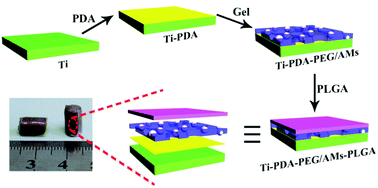Dopamine-assisted fixation of drug-loaded polymeric multilayers to osteoarticular implants for tuberculosis therapy†
Abstract
Currently, the major issues in the treatment of osteoarticular tuberculosis (TB) after implant placement are low drug concentration at the infected focus and drug resistance resulting from the long-term chemotherapy. The application of drug-loaded polymeric multilayers on implantable devices offers a promising solution to the problems. Herein, a poly(ethylene glycol)-based hydrogel film embedded with isoniazid (INH)-loaded alginate microparticles was fixed to Ti implants via adhesive polydopamine, subsequently capped by poly(lactic-co-glycolic acid) membranes for the sustained and localized delivery of the anti-TB drug. The antibacterial efficacy of the released INH was confirmed by a 4.5 ± 0.8 cm inhibition zone formed in the fourth week after inoculation of Mycobacterium tuberculosis. The INH-loaded Ti implants showed no toxicity to the osteoblast cell and provided a consistent drug release for nearly one week in vitro. The release profile in vivo showed a high local concentration and low systemic exposure. The local INH concentration could be kept higher than its minimum inhibitory concentration over a period of 8 weeks, which proves that it is a promising strategy to improve the severe osteoarticular TB treatment.



 Please wait while we load your content...
Please wait while we load your content...